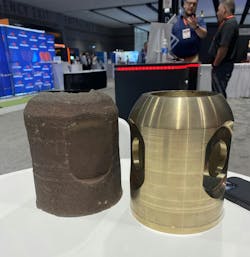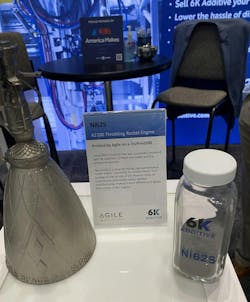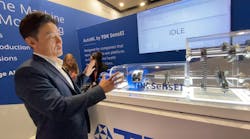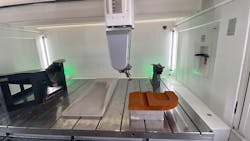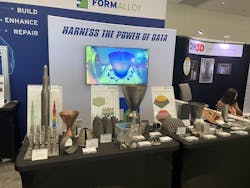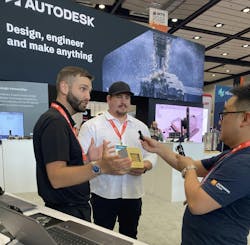Discovering the Future of Manufacturing at the International Manufacturing Technology Show
This article original posted on Sept. 12, 2024, and was updated on Sept. 18, 2024.
After three days at my first International Manufacturing Technology Show (IMTS), I was inspired by the multitude of innovative advancements in manufacturing technology showcased throughout the event. Although I was’t be able to return for the remaining three days, I was grateful for the incredible insights gained during my visit. The variety of exhibits and the solutions presented by so many companies highlight the exciting future of this industry.
Let’s look at a smattering of the companies leading the way in the manufacturing industry. Among them, SPEE3D displayed cutting-edge additive manufacturing techniques, particularly focused on materials designed for defense applications—including nickel aluminum bronze and copper nickel—to bolster the U.S. Navy’s capabilities. Its unique rocket nozzle technology allows for rapid production of complex parts, a game-changer in the maritime industrial sector.
Also in the materials realm, 6K Additive got attention for its metal powders that are specifically engineered for additive manufacturing.
READ MORE: Day 3 Offers Candid Insights from the Heart of IMTS 2024
TDK SensEI presented an impressive fault simulator leveraging its advanced sensor technology, which utilizes integrated AI to monitor machine conditions in real-time, providing continuous operational oversight akin to having a service technician on hand 24/7. Meanwhile, Zimmermann showcased its smallest machine, the FZU 22, adept at processing various materials essential for aerospace and automotive sectors.
Following suit, FormAlloy announced the launch of its Application Development Center and its novel DED Smart Path technology, tailored for directed energy deposition. This module aims to be the future of part repair and manufacturing, offering significant efficiency gains and quality control enhancements.
Here is a more in-depth look at each.
SPEE3D, Booth #432416
This year, SPEE3D has focused on developing materials like nickel aluminum bronze and copper nickel for the U.S. Navy, aimed at enhancing the maritime industrial base. Using a rocket nozzle to heat air enables the firing of material particles at high velocities to create parts quickly—up to a pound in a few hours compared to days using traditional methods. Key features of their manufacturing process include:
- Materials: They work with several materials, including nickel aluminum bronze and copper nickel, and their system is open-source, allowing experimentation with different alloys.
- Rapid production: Parts can be printed significantly faster than with other metal technologies, such as laser or wire arc methods.
- Application: The printed components, like a variable pitch propeller housing, can be used in submarines and other marine vehicles, noting that nickel aluminum bronze is advantageous in corrosive saltwater environments.
Once printed, parts undergo heat treatment to minimize voids and are then traditionally machined to achieve final specifications. Mark Menninger told Machine Design that SPEE3D is also developing a new platform, the Titan Speed, in 2025, enabling the production of much larger parts (up to 4,000 lb), moving from their current range of 90 lb. They also have created an expeditionary manufacturing unit to deploy technology in field operations, where printers can be set up on-site to produce and machine parts as needed. Overall, SPEE3D aims to support both military and commercial sectors with their advanced manufacturing capabilities while fostering innovation through their open-source system.
6K Additive, Booth #433024
Bruce Bradshaw and Brian Morrison from 6K Additive said visitors to their booth talked about the demand for education about these materials, particularly their high-performance alloys like nickel-based super alloys and titanium alloys, which are used in applications ranging from medical implants to aerospace components.
The company introduced its angular metal powders, designed for thermal spray, cold spray and metal injection molding, which differ from its usual spherical powders but maintain high purity levels.
READ MORE: Innovation Takes Center Stage at IMTS 2024
The said 6K’s unique “unit melt process” allows them to utilize flexible, sustainable raw material sources, such as scrap and machining chips. This process creates spherical powder particles via injection into a high-temperature microwave-generated plasma stream.
Fun fact: Bradshaw said the name “6K Additive” refers to the plasma’s temperature of 6,000 degrees Kelvin, which is also the temperature of the sun’s surface, “adding a marketing twist.”
TDK SensEI, Booth #433130
The fault simulator showcased how TDK sensors, specifically its device with an integrated accelerometer, gyroscope and artificial intelligence (AI), can monitor machine conditions and detect faults during operation. The AI processes sensor data in real-time on-site, eliminating the need for cloud data transmission. When the machine is powered on, the AI initially confirms normal operation. Users can simulate various faults, such as vibrations from the motor, gearbox or chains, allowing the AI to identify and classify issues accurately, even from a distance. Sang Lee, TDK SensEI’s chief commercial officer, told Machine Design this continuous monitoring mimics the presence of a service technician, providing 24/7 oversight of the machine’s condition.
Zimmermann, Booth #339336
The new Zimmermann FZU 22 machine can handle materials like Nomex honeycomb—commonly used in aerospace—and is suitable for ultrasonic cutting of both honeycomb and foam. Additionally, it can process RAM port model board material for creating models, particularly in automotive applications. The machine can also produce molds for composite parts, enabling trimming and finishing of these components.
FormAlloy, Booth #433018
Melanie Lang, co-founder and CEO of FormAlloy, made two significant announcements at IMTS: the opening of the company’s new Application Development Center and the introduction of a new technology module called DED Smart Path.
The company specializes in metal additive manufacturing, particularly directed energy deposition, which allows for creating and repairing parts. The Application Development Center, which opened at the end of July, is designed to help customers test and validate this technology for various applications. It offers R&D, prototyping and low-rate production services while also providing educational opportunities and intern programs. Lang reported that Rep. Sara Jacobs (D-Calif.) attended the event and praised the center’s positive community impact, highlighting its importance for defense customers like NAVAIR, which reported significant cost savings through more efficient repair solutions.
READ MORE: Robotics at IMTS 2024: Show Launches, Market Ripples, Partnerships and More
Lang also talked about the importance of data collection during manufacturing to ensure quality and speed up the transition to end-use applications.
The second announcement featured DED Smart Path technology, which allows users to scan existing parts or substrates to automatically generate tool paths, eliminating the need for traditional CAD models and manual slicing processes. She said this technology is especially beneficial for applications like turbine blade repair, where each blade may have unique wear characteristics. There are two integration options for this module: It can operate as a separate unit outside the machine or be fully integrated into existing machines, allowing for greater workflow flexibility. This technology serves multiple industries, including defense, aerospace and consumer goods.
A Personal Connection Amidst Industry Innovation
Among the incredible displays and advancements at the show, I felt a special pride when I learned that my nephew Kevin Strom, a CNC machinist who was attending the event, participated in the deburring contest at the Autodesk booth (#133310) and clinched the win.
His achievement of deburring the part in 1 min., 26 sec. secured him bragging rights and a Bluetooth speaker engraved with Autodesk’s logo. It also put a spotlight on the hands-on talent in the manufacturing industry as well as highlights the excitement and engagement that events like IMTS provide to those in the industry. It’s a great reminder that the future of manufacturing is not just in technology but in the passionate individuals ready to embrace it.
Check out more coverage from Machine Design’s IMTS 2024 content hub.

